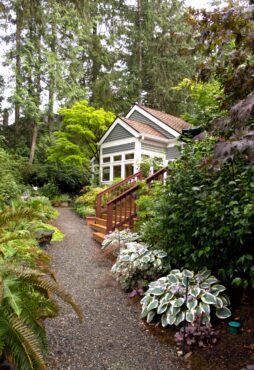 Tucked into a leafy Gig Harbor glen among native plants such as salal and huckleberry is a singing creek that drops into a pool surrounded by purposefully planted perennials. The sunlight catches a flash of gold or orange as a goldfish darts between the rocks of the pond. Two Adirondack chairs sit at the side of the pond where homeowners Bob and Jane Ostericher enjoy coffee and breakfast on summer mornings, sit and read on a quiet afternoon or sip a glass of wine in the evening.
Tucked into a leafy Gig Harbor glen among native plants such as salal and huckleberry is a singing creek that drops into a pool surrounded by purposefully planted perennials. The sunlight catches a flash of gold or orange as a goldfish darts between the rocks of the pond. Two Adirondack chairs sit at the side of the pond where homeowners Bob and Jane Ostericher enjoy coffee and breakfast on summer mornings, sit and read on a quiet afternoon or sip a glass of wine in the evening.
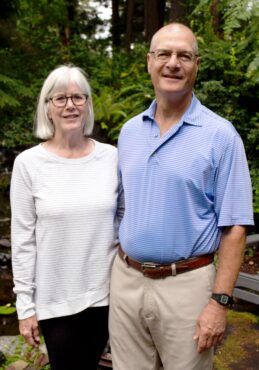
This idyllic sanctuary has been developed and lovingly tended since the Osterichers purchased their Canterwood home 27 years ago.
“We were fortunate in that the original owners and builders preserved much of the native landscape around the perimeter of the lot,” Jane Ostericher said. “We have continued to maintain that natural border while adding other natives and non-natives to add year-round color, interest and value for wildlife to the gardens.”
Bob Ostericher is a retired surgeon whose career in the U.S. Air Force moved the family to several interesting locations over the years. Jane said she may have been “bitten by the gardening bug” during their stint in England, where she took every available opportunity to visit gardens of large and small repute.
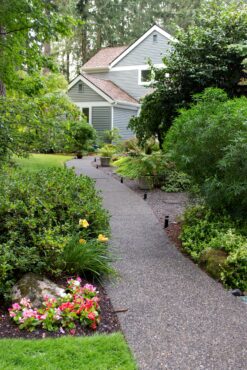 When they came to the Northwest, the couple fell in love with their present home because of the architecture and the way it’s placed on the lot, nestled into the natural small hill. As lovers of the outdoors, they were impressed by the natural border of huckleberry and salal that surrounded the lot, and the mature Douglas fir trees left in place during the building process.
When they came to the Northwest, the couple fell in love with their present home because of the architecture and the way it’s placed on the lot, nestled into the natural small hill. As lovers of the outdoors, they were impressed by the natural border of huckleberry and salal that surrounded the lot, and the mature Douglas fir trees left in place during the building process.
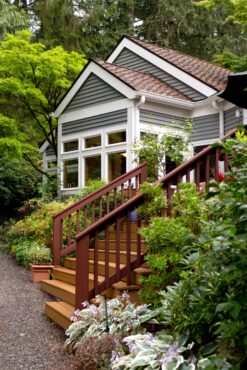 While the bones of the original landscape in the front of the house were strong, the plants and hardscape accounted for only about 25 percent of the total garden surrounding the house as it is today.
While the bones of the original landscape in the front of the house were strong, the plants and hardscape accounted for only about 25 percent of the total garden surrounding the house as it is today.
Jane Ostericher describes herself as a “mostly self-taught” gardener. To learn about the basic principles of landscape design, she took a community college class. In 2011, Ostericher enrolled in a Washington State University Master Gardener class and has remained active in the Pierce County Master Gardner organization ever since. She is also a member of the Washington Native Plant Society to support her interest in native flora.
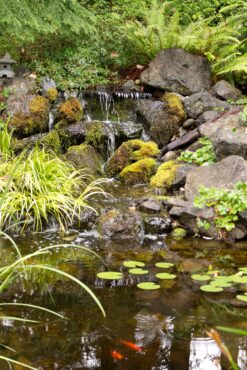 In the front garden, large native shrubs, non-natives that thrive in this climate zone and some native hybrids serve as the understory to the towering trees. A path meanders between beds of perennials and groundcovers, all designed to offer interest throughout the year, coming into bloom in succession, or the foliage changing color due to the season. Ostericher feels the front garden is the most attractive and colorful in the spring.
In the front garden, large native shrubs, non-natives that thrive in this climate zone and some native hybrids serve as the understory to the towering trees. A path meanders between beds of perennials and groundcovers, all designed to offer interest throughout the year, coming into bloom in succession, or the foliage changing color due to the season. Ostericher feels the front garden is the most attractive and colorful in the spring.
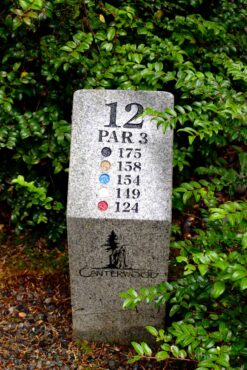 Wandering around the side of the house reveals a small greenhouse and offers a glimpse into the Canterwood Golf Course, quickly hidden by the native plant border that separates the fairway from the Ostericher property.
Wandering around the side of the house reveals a small greenhouse and offers a glimpse into the Canterwood Golf Course, quickly hidden by the native plant border that separates the fairway from the Ostericher property.
An expansive deck connects the house to the back garden. Large pots on the deck contain the roses Ostericher loves, and the deer are discouraged from eating the flowers growing so close to the house. The couple use their deck as an extension of their home by entertaining small groups of close friends out of doors on a regular basis.
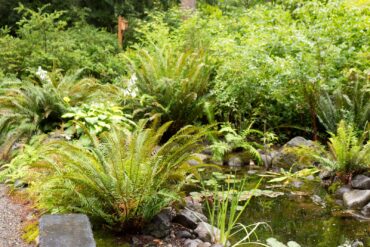 On a visit to the Wild Bird store in Sequim several years ago, the pair discovered a beautiful, natural-appearing water feature, and Ostericher told her husband she would like a similar one in celebration of their 25th wedding anniversary. In 2008, the couple employed Mark the Pond Guy through Windmill Gardens to install their complex double stream and hand-dug pond feature.
On a visit to the Wild Bird store in Sequim several years ago, the pair discovered a beautiful, natural-appearing water feature, and Ostericher told her husband she would like a similar one in celebration of their 25th wedding anniversary. In 2008, the couple employed Mark the Pond Guy through Windmill Gardens to install their complex double stream and hand-dug pond feature.
Incorporating the design into the natural border gives the water a totally natural appearance. A very large, old Douglas fir stands right in the middle of the spot where the stream would have run between the upper and lower ponds.
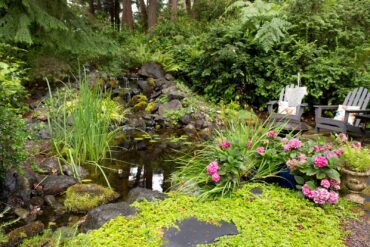 The solution was to split the waterways and build in some little waterfalls, which often occurs in nature, too. The upper pond, where the water originates, is deep enough for fish and water plants and has been landscaped to appear as if it has always been there.
The solution was to split the waterways and build in some little waterfalls, which often occurs in nature, too. The upper pond, where the water originates, is deep enough for fish and water plants and has been landscaped to appear as if it has always been there.
The smaller, lower pond catches a little more light and is surrounded by perennials that require more sun. The water feature is designed to attract birds and other small animals, and the homeowners depend on water plants and other natural solutions to keep the water clean.
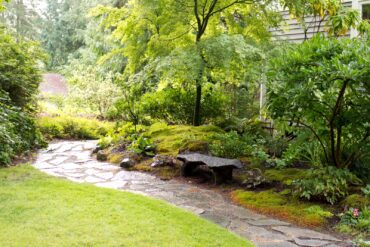 Ostericher prides herself on being a natural gardener, using an organic and integrated pest-management system, healthy for all the bees and butterflies, birds and other animals that are attracted to the garden. The garden is designated as a Certified Wildlife Habitat by the National Wildlife Foundation.
Ostericher prides herself on being a natural gardener, using an organic and integrated pest-management system, healthy for all the bees and butterflies, birds and other animals that are attracted to the garden. The garden is designated as a Certified Wildlife Habitat by the National Wildlife Foundation.
Ostericher gardens by intuition, looking at a space and envisioning a plant that would thrive there, then researching to find just the right one — taking space, soil and light conditions into consideration.
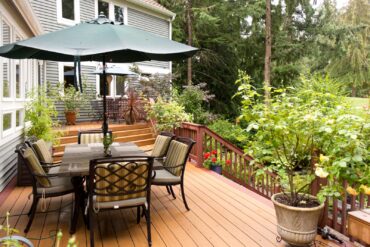 “Over the past 25 years, the native firs, hemlocks and cedars have grown tall and now a prominent theme of the garden is ‘gardening in the shade and partial shade,'” she says with a laugh.
“Over the past 25 years, the native firs, hemlocks and cedars have grown tall and now a prominent theme of the garden is ‘gardening in the shade and partial shade,'” she says with a laugh.
The inspiration for the Osterichers’ very personal design comes from the peacefulness of Japanese garden design and the couple’s love of Northwest native plants.
“I have found hybrids of our native plants often are heartier and more lush than the natives themselves, so I frequently use them,” Ostericher said. She chooses most of the plantings, and the couple both do all of the garden maintenance themselves.
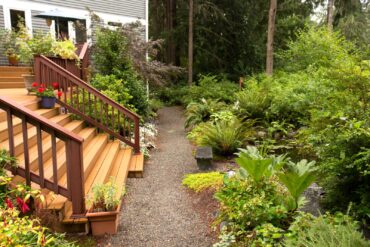 When not at home tending and enjoying the fruits of their gardening labor, the Osterichers enjoy playing golf, fly fishing, hiking, skiing and traveling. They maintain a cabin in the Olympics.
When not at home tending and enjoying the fruits of their gardening labor, the Osterichers enjoy playing golf, fly fishing, hiking, skiing and traveling. They maintain a cabin in the Olympics.
“No landscaping there — we just enjoy the naturally occurring plants and trim back as necessary,” Ostericher said.
She is also very involved in Gig Harbor Gardeners, the neighborhood affiliate of Northwest Perennial Alliance, and is chairperson of the WSU Extension Pierce County Master Gardener Demonstration Garden located inside Sehmel Homestead Park. Ostericher has served in several capacities during her tenure with the Washington Native Plant society and currently serves as the South Sound publicity chairperson.
What advice would this experienced gardener give to others?
“Look for ways to add and retain native plants, reduce lawns, keep up with weeding and find ways to use integrated pest management to protect our birds and pollinators,” she said. “Above all, enjoy your garden.”




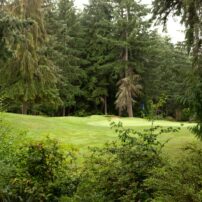
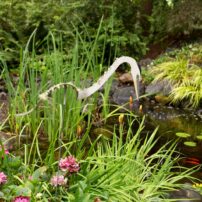
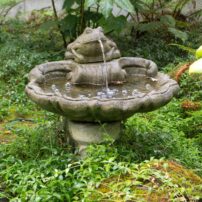
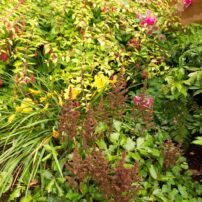
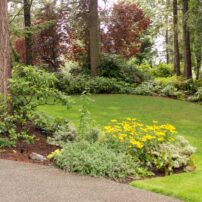
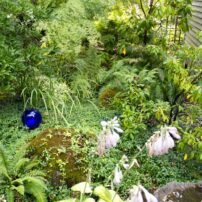
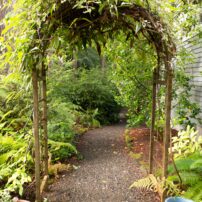

























Comments